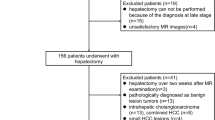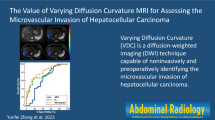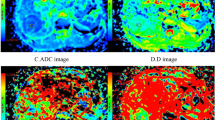Abstract
Objectives
Impeded diffusion fraction (IDF) is a novel and promising diffusion-weighted imaging (DWI) technique that allows for the detection of various diffusion compartments, including macromolecular coordinated water, free diffusion, perfusion, and cellular free water. This study aims to investigate the clinical potential of IDF-DWI in detecting microvascular invasion (MVI) in hepatocellular carcinoma (HCC).
Methods
66 patients were prospectively included. Metrics derived from IDF-DWI and the apparent diffusion coefficient (ADC) were calculated. Multivariate logistic regression was employed to identify clinical risk factors. Diagnostic performance was evaluated using the area under the receiver operating characteristics curve (AUC-ROC), the area under the precision-recall curve (AUC-PR), and the calibration error (cal-error). Additionally, a power analysis was conducted to determine the required sample size.
Results
The results suggested a significantly higher fraction of impeded diffusion (FID) originating from IDF-DWI in MVI-positive HCCs (p < 0.001). Moreover, the ADC was found to be significantly lower in MVI-positive HCCs (p = 0.019). Independent risk factors of MVI included larger tumor size and elevated alpha-fetoprotein (AFP) levels. The nomogram model incorporating ADC, FID, tumor size, and AFP level yielded the highest diagnostic accuracy for MVI (AUC-PR = 0.804, AUC-ROC = 0.783, cal-error = 0.044), followed by FID (AUC-PR = 0.693, AUC-ROC = 0.760, cal-error = 0.060) and ADC (AUC-PR = 0.570, AUC-ROC = 0.651, cal-error = 0.164).
Conclusion
IDF-DWI shows great potential in noninvasively, accurately, and preoperatively detecting MVI in HCC and may offer clinical benefits for prognostic prediction and determination of treatment strategy.
Graphical abstract







Similar content being viewed by others
Abbreviations
- MVI:
-
Microvascular invasion
- HCC:
-
Hepatocellular carcinoma
- IDF:
-
Impeded diffusion fraction
- DWI:
-
Diffusion-weighted imaging
- ADC:
-
Apparent diffusion coefficient
- AUC-ROC:
-
Area under the receiver operating characteristics curve
- AUC-PR:
-
Area under the precision-recall curve
- Cal-Error:
-
Calibration error
- AFP:
-
Alpha-fetoprotein
- D f :
-
Diffusion coefficient of free diffusion
- F f :
-
Volume fraction of free diffusion
- F C :
-
Volume fraction of the subcellular component
- F fc :
-
Volume fraction of cellular free (uncoordinated) water fraction
- F ID :
-
Volume fraction of impeded (coordinated) water fraction
- F P :
-
Volume fraction of vascular perfusion
References
Sangro B, Sarobe P, Hervás-Stubbs S, Melero I (2021) Advances in immunotherapy for hepatocellular carcinoma. Nature reviews Gastroenterology & hepatology 18:525-543
Yang JD, Hainaut P, Gores GJ, Amadou A, Plymoth A, Roberts LR (2019) A global view of hepatocellular carcinoma: trends, risk, prevention and management. Nature reviews Gastroenterology & hepatology 16:589-604
Craig AJ, Von Felden J, Garcia-Lezana T, Sarcognato S, Villanueva A (2020) Tumour evolution in hepatocellular carcinoma. Nature reviews Gastroenterology & hepatology 17:139-152
Mazzaferro V, Sposito C, Zhou J et al (2018) Metroticket 2.0 model for analysis of competing risks of death after liver transplantation for hepatocellular carcinoma. Gastroenterology 154:128-139
Kardashian A, Florman SS, Haydel B et al (2020) Liver transplantation outcomes in a US multicenter cohort of 789 patients with hepatocellular carcinoma presenting beyond Milan criteria. Hepatology 72:2014-2028
Villanueva A (2019) Hepatocellular Carcinoma. N Engl J Med 380:1450-1462
Erstad DJ, Tanabe KK (2019) Prognostic and Therapeutic Implications of Microvascular Invasion in Hepatocellular Carcinoma. Annals Of Surgical Oncology 26:1474-1493
Sugawara Y, Hibi T (2021) Surgical treatment of hepatocellular carcinoma. Biosci Trends 15:138-141
Isik B, Gonultas F, Sahin T, Yilmaz S (2020) Microvascular Venous Invasion in Hepatocellular Carcinoma: Why Do Recurrences Occur? J Gastrointest Cancer 51:1133-1136
Zheng Z, Guan R, Jianxi W et al (2022) Microvascular Invasion in Hepatocellular Carcinoma: A Review of Its Definition, Clinical Significance, and Comprehensive Management. J Oncol 2022:9567041
Hwang S, Lee Y-J, Kim K-H et al (2015) The impact of tumor size on long-term survival outcomes after resection of solitary hepatocellular carcinoma: single-institution experience with 2558 patients. Journal Of Gastrointestinal Surgery 19:1281-1290
Shi M, Guo R-P, Lin X-J et al (2007) Partial hepatectomy with wide versus narrow resection margin for solitary hepatocellular carcinoma: a prospective randomized trial. Annals Of Surgery 245:36
Zhang Y, Sheng R, Yang C, Dai Y, Zeng M (2023) Higher field reduced FOV diffusion-weighted imaging for abdominal imaging at 5.0 Tesla: image quality evaluation compared with 3.0 Tesla. Insights into Imaging 14:171
Zhang Y, Yang C, Liang L et al (2022) Preliminary Experience of 5.0 T Higher Field Abdominal Diffusion-Weighted MRI: Agreement of Apparent Diffusion Coefficient With 3.0 T Imaging. J Magn Reson Imaging 56:1009-1017
Qin Y, Tang C, Hu Q et al (2023) Quantitative assessment of restriction spectrum MR imaging for the diagnosis of breast cancer and association with prognostic factors. Journal of Magnetic Resonance Imaging 57:1832-1841
Wang C, Wang G, Zhang Y et al (2023) Differentiation of benign and malignant breast lesions using diffusion-weighted imaging with a fractional-order calculus model. European Journal Of Radiology 159:110646
Chen J, Liu D, Guo Y et al (2023) Preoperative identification of cytokeratin 19 status of hepatocellular carcinoma based on diffusion kurtosis imaging. Abdominal Radiology 48:579-589
Sheng R, Zhang Y, Sun W et al (2022) Staging chronic hepatitis b related liver fibrosis with a fractional order calculus diffusion model. Academic Radiology 29:951-963
Tang L, Zhou XJ (2019) Diffusion MRI of cancer: From low to high b‐values. Journal of Magnetic Resonance Imaging 49:23-40
Zhang Y, Yang C, Sheng R, Dai Y, Zeng M (2023) Preoperatively Identify the Microvascular Invasion of Hepatocellular Carcinoma with the Restricted Spectrum Imaging. Academic Radiology
Hirsch KG, Fischbein N, Mlynash M et al (2020) Prognostic value of diffusion-weighted MRI for post-cardiac arrest coma. Neurology 94:e1684-e1692
Zaninovich OA, Avila MJ, Kay M, Becker JL, Hurlbert RJ, Martirosyan NL (2019) The role of diffusion tensor imaging in the diagnosis, prognosis, and assessment of recovery and treatment of spinal cord injury: a systematic review. Neurosurgical focus 46:E7
Malyarenko DI, Swanson SD, McGarry SD, LaViolette PS, Chenevert TL (2022) The impeded diffusion fraction quantitative imaging assay demonstrated in multi‐exponential diffusion phantom and prostate cancer. Magnetic Resonance in Medicine 87:2053-2062
Cao L, Chen J, Duan T et al (2019) Diffusion kurtosis imaging (DKI) of hepatocellular carcinoma: correlation with microvascular invasion and histologic grade. Quantitative Imaging in Medicine and Surgery 9:590
Wang W-T, Yang L, Yang Z-X et al (2018) Assessment of microvascular invasion of hepatocellular carcinoma with diffusion kurtosis imaging. Radiology 286:571-580
Chen J, Guo Y, Guo Y et al (2023) Preoperative assessment of microvascular invasion of hepatocellular carcinoma using non-Gaussian diffusion-weighted imaging with a fractional order calculus model: A pilot study. Magn Reson Imaging 95:110-117
Guo Y, Chen J, Zhang Y et al (2022) Differentiating Cytokeratin 19 expression of hepatocellular carcinoma by using multi-b-value diffusion-weighted MR imaging with mono-exponential, stretched exponential, intravoxel incoherent motion, diffusion kurtosis imaging and fractional order calculus models. Eur J Radiol 150:110237
Sheng R, Zhang Y, Wang H et al (2023) A multi-center diagnostic system for intrahepatic mass-forming cholangiocarcinoma based on preoperative MRI and clinical features. Eur Radiol. https://doi.org/10.1007/s00330-023-10002-w
Song M, Wang Q, Feng H, Wang L, Zhang Y, Liu H (2023) Preoperative Grading of Rectal Cancer with Multiple DWI Models, DWI-Derived Biological Markers, and Machine Learning Classifiers. Bioengineering 10:1298
Zhang Y, Sheng R, Yang C, Dai Y, Zeng M (2023) The Feasibility of Using Tri-Exponential Intra-Voxel Incoherent Motion DWI for Identifying the Microvascular Invasion in Hepatocellular Carcinoma. Journal of Hepatocellular Carcinoma:1659–1671
Zhang Y, Yang C, Sheng R, Dai Y, Zeng M (2023) Preoperatively Identify the Microvascular Invasion of Hepatocellular Carcinoma with the Restricted Spectrum Imaging. Acad Radiol 30 Suppl 1:S30-S39
Xiong Z, Geng Z, Lian S et al (2022) Discriminating rectal cancer grades using restriction spectrum imaging. Abdom Radiol (NY) 47:2014-2022
Surov A, Pech M, Omari J et al (2021) Diffusion-weighted imaging reflects tumor grading and microvascular invasion in hepatocellular carcinoma. Liver Cancer 10:10-24
Suh YJ, Kim MJ, Choi JY, Park MS, Kim KW (2012) Preoperative prediction of the microvascular invasion of hepatocellular carcinoma with diffusion‐weighted imaging. Liver Transplantation 18:1171-1178
Deng Y, Li J, Xu H et al (2022) Diagnostic Accuracy of the Apparent Diffusion Coefficient for Microvascular Invasion in Hepatocellular Carcinoma: A Meta-analysis. Journal of clinical and translational hepatology 10:642
Wang H, Lu Y, Liu R, Wang L, Liu Q, Han S (2021) A non-invasive nomogram for preoperative prediction of microvascular invasion risk in hepatocellular carcinoma. Front Oncol 11:745085
Li H, Li T, Hu J, Liu J (2021) A nomogram to predict microvascular invasion in early hepatocellular carcinoma. Journal of Cancer Research and Therapeutics 17:652-657
Acknowledgements
This study has received funding by the National Natural Science Foundation of China (grant number 82371923), the National Natural Science Foundation of China (grant number 82171897), Shanghai Municipal Health Commission (grant number 202240152), and Science and Technology Commission of Shanghai Municipality (grant number 23Y11907400).
Funding
This study has received funding by the National Natural Science Foundation of China (Grant number 82371923), the National Natural Science Foundation of China (Grant number 82171897), Shanghai Municipal Health Commission (Grant number 202240152), and Science and Technology Commission of Shanghai Municipality (Grant number 23Y11907400).
Author information
Authors and Affiliations
Contributions
All authors attest that they meet the current International Committee of Medical Journal Editors (ICMJE) criteria for Authorship.
Corresponding authors
Additional information
Publisher's Note
Springer Nature remains neutral with regard to jurisdictional claims in published maps and institutional affiliations.
Rights and permissions
Springer Nature or its licensor (e.g. a society or other partner) holds exclusive rights to this article under a publishing agreement with the author(s) or other rightsholder(s); author self-archiving of the accepted manuscript version of this article is solely governed by the terms of such publishing agreement and applicable law.
About this article
Cite this article
Zhang, Y., Sheng, R., Yang, C. et al. Detecting microvascular invasion in hepatocellular carcinoma using the impeded diffusion fraction technique to sense macromolecular coordinated water. Abdom Radiol (2024). https://doi.org/10.1007/s00261-024-04230-x
Received:
Revised:
Accepted:
Published:
DOI: https://doi.org/10.1007/s00261-024-04230-x




